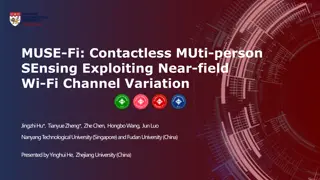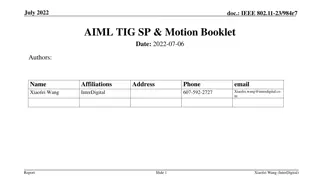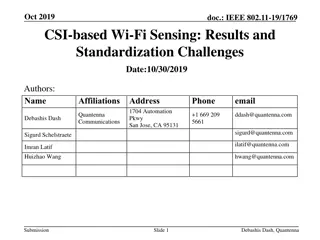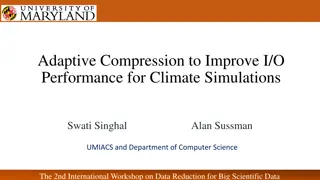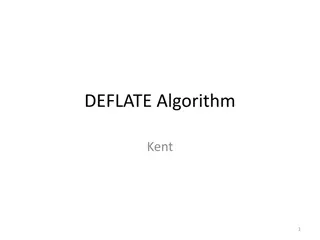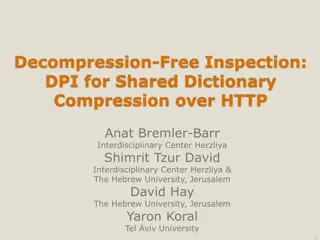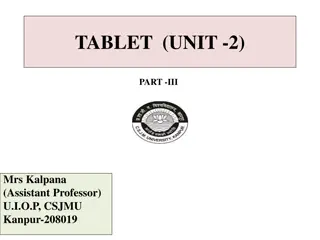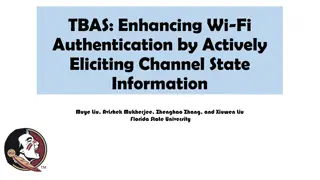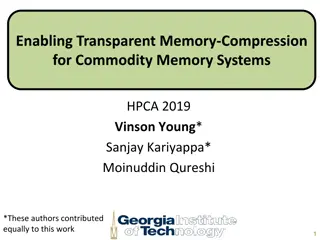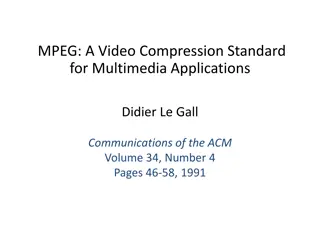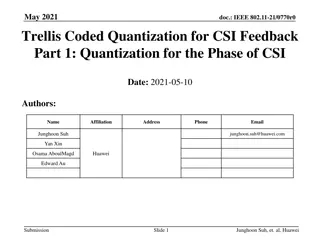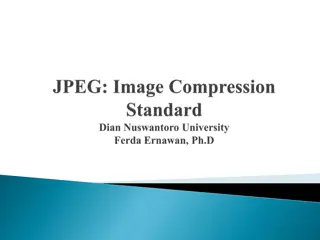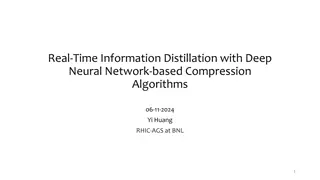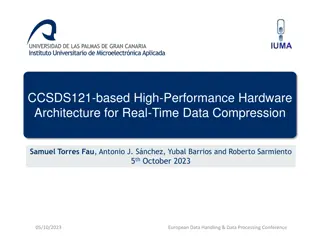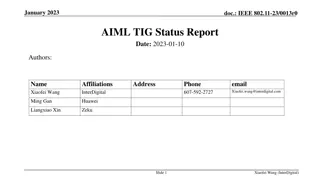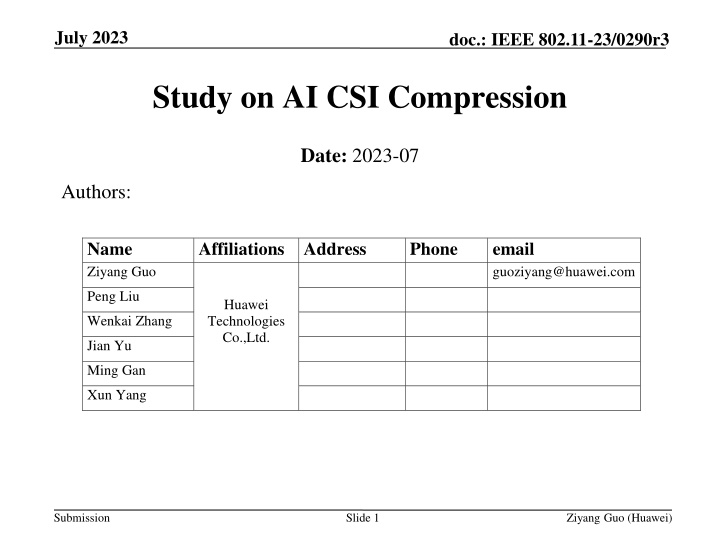
Study on AI CSI Compression Using VQVAE for IEEE 802.11-23
Explore the study on AI CSI compression utilizing Vector Quantized Variational Autoencoder (VQVAE) in IEEE 802.11-23. The research delves into model generalization, lightweight encoder development, and bandwidth variations for improved performance in CSI compression. Learn about ML solutions, existing work, and the proposed VQVAE method's components like encoder, codebook, and decoder for automatic data compression and quantization.
Download Presentation

Please find below an Image/Link to download the presentation.
The content on the website is provided AS IS for your information and personal use only. It may not be sold, licensed, or shared on other websites without obtaining consent from the author. If you encounter any issues during the download, it is possible that the publisher has removed the file from their server.
You are allowed to download the files provided on this website for personal or commercial use, subject to the condition that they are used lawfully. All files are the property of their respective owners.
The content on the website is provided AS IS for your information and personal use only. It may not be sold, licensed, or shared on other websites without obtaining consent from the author.
E N D
Presentation Transcript
July 2023 doc.: IEEE 802.11-23/0290r3 Study on AI CSI Compression Date: 2023-07 Authors: Name Ziyang Guo Affiliations Address Huawei Technologies Co.,Ltd. Phone email guoziyang@huawei.com Peng Liu Wenkai Zhang Jian Yu Ming Gan Xun Yang Submission Slide 1 Ziyang Guo (Huawei)
July 2023 doc.: IEEE 802.11-23/0290r3 Abstract In r1 [5], we introduced a new vector quantized variational autoencoder (VQVAE) method for CSI compression and discussed its performance. In r2 [6], we have a follow-up discussion on Further feedback overhead reduction and goodput improvement, Model generalization under different channel conditions and different numbers of antennas/spatial streams Workflow of AI CSI compression using VQVAE. In this revision (r3), we continue the study on Model generalization under different bandwidths, Lightweight encoder that reduces computation complexity and model deployment overhead. Submission Slide 2 Ziyang Guo (Huawei)
July 2023 doc.: IEEE 802.11-23/0290r3 R1 - Background The AP initiates the sounding sequence by transmitting the NDPA frame followed by a NDP which is used for the generation of V matrix at the STA. The STA applies Givens rotation on the V matrix and feeds back the angels in the beamforming report frame. ??+?? ? and number of antennas lead to significantly increased sounding feedback overhead, which increases the latency and limits the throughput gain. Visualization of the precoding matrix after FFT shows its sparsity and compressibility. ??? The total feedback overhead is ?? ??. Larger bandwidth Ntx=Nrx=Nss BW=20MHz BW=40MHz BW=80MHz BW=160MHz BW=320MHz 2 0.12 (KBytes) 0.24 0.50 1.00 1.99 4 0.73 1.45 2.99 5.98 11.95 8 3.39 6.78 13.94 27.89 55.78 16 14.52 29.04 59.76 119.52 239.04 20MHz, 8*2 Submission Slide 3 Ziyang Guo (Huawei)
July 2023 doc.: IEEE 802.11-23/0290r3 R1 - Existing Work on AI CSI Compression ML solutions: no neural network [1][2] adopted a traditional machine learning algorithm, i.e., K-means, to cluster the angle vector after Givens rotation Beamformer and beamformee need to exchange and store the centroids Only transmit the centroid index during inference 2dB PER loss, up to 50% goodput improvement AI solutions: use neural network [3] adopted two autoencoders to compress two types of angles after Givens rotation separately Beamformer and beamformee need to exchange the store neural network models Only transmit the encoder output during inference Up to 70% overhead reduction and 60% throughput gain for 11ac system Submission Slide 4 Ziyang Guo (Huawei)
July 2023 doc.: IEEE 802.11-23/0290r3 R1 - Our Study on AI CSI Compression Vector quantization variational autoencoder (VQVAE) [4] is proposed for CSI compression Consists of encoder, codebook, decoder Learn how to compress and quantize automatically from the data Convolutional neural network (CNN) or transformer could be used for both the encoder and decoder. Input of NN could be the V matrix or the angles after Givens rotation. Beamformer and beamformee need to exchange and store the codebook and half of the NN model. Only transmit the codeword index during inference. Submission Slide 5 Ziyang Guo (Huawei)
July 2023 doc.: IEEE 802.11-23/0290r3 R1 - Performance Evaluation Simulation setup: Training data are generated under SU MIMO, channel D NLOS, BW=80MHz, Ntx=8, Nrx=2, Nss=2, Ng=4 TNDPA=28us, TNDP=112us, TSIFS=16us, Tpreamble=64us, MCS=1 for BF report, MCS=7 for data, payload length=1000Bytes Comparison Baseline: current methods in the standard, Ng=4 (250 subcarriers) and Ng=16 (64 subcarriers) with ??= 6 and ??= 4 Performance Metric: Goodput: GP = successful data transmitted ? (1 ???) = total time duration ?????+????+???+?????+????+4 ????? Compression ratio: Rc = legacy BF feedback bits AI BF feedback bits SIFS SIFS SIFS SIFS SNR-PER curve Data NDPA NDP BF ACK Submission Slide 6 Ziyang Guo (Huawei)
July 2023 doc.: IEEE 802.11-23/0290r3 R1 - Performance Evaluation ,MCS=7 Rc=12 (CB size 1024) Rc=25 (CB size 1024) Loss @ 0.01 PER (dB) vs Ng=4 0.16 0.5 loss @ 0.01 PER (dB) vs Ng=16 0 0.4 overhead Ng=4 (bits) overhead Ng=16 (bits) overhead VQVAE (bits) Rc Rc GP Ng=4 (Mbps) GP Ng=16 (Mbps) GP AI (Mbps) GP gain (%) vs Ng=4 GP gain (%) vs Ng=16 Method vs Ng=4 vs Ng=16 VQVAE-1 VQVAE-2 32500 32500 8320 8320 2560 1280 12.70 25.39 3.25 6.50 5.07 5.07 10.77 10.77 14.70 16.00 189.64 215.20 36.48 48.53 Submission Slide 7 Ziyang Guo (Huawei)
July 2023 doc.: IEEE 802.11-23/0290r3 Further Study in R2 Reduce the feedback overhead and improve the goodput Different neural network architecture Reduce codebook size and dimension More complex scenarios More simulations under different configurations MU-MIMO scenarios Increase model generalization One neural network can exhibit robustness to different channel models One neural network can exhibit robustness to different bandwidth One neural network can exhibit robustness to number of antennas Submission Slide 8 Ziyang Guo (Huawei)
July 2023 doc.: IEEE 802.11-23/0290r3 R2 - Feedback overhead reduction and goodput improvement Simulation setup: SU MIMO, channel D NLOS, BW=80MHz, Ntx=8, Nrx=Nss=2 Higher compression ratio and more MCS are considered Comparison baseline Standard: Givens, Ng=4/16, ??=6, ??=4 VQVAEs with different compression ratios achieve less than 1dB PER loss compared with standard method. Rc=12 (CB size 1024) Rc=25 (CB size 1024) Rc=36 (CB size 128) Submission Slide 9 Ziyang Guo (Huawei)
July 2023 doc.: IEEE 802.11-23/0290r3 R2 - Goodput improvement and feedback overhead reduction SIFS Performance Metric: Goodput: GP = successful data transmitted SIFS SIFS SIFS Data NDPA NDP total time duration ? (1 ???) BF ACK = ?????+????+???+?????+????+4 ????? Compression ratio: Rc = legacy BF feedback bits AI BF feedback bits Parameters for goodput calculation: TNDPA=28us, TNDP=112us, TSIFS=16us, Tpreamble=64us, MCS=1 for BF report, MCS=7 for data, L=1000Bytes, PER=0.01 overhead VQVAE (bits) 2560 1280 896 Loss @ 0.01 PER (dB) vs Ng=4 0.16 0.5 0.9 loss @ 0.01 PER (dB) vs Ng=16 0 0.4 0.8 GP GP gain (%) vs Ng=4 189.64 215.20 223.77 GP gain (%) vs Ng=16 36.48 48.53 52.57 overhead Ng=4 (bits) overhead Ng=16 (bits) Rc Rc GP Ng=4 (Mbps) GP AI (Mbps) Method VQ size Ng=16 (Mbps) 10.77 10.77 10.77 vs Ng=4 vs Ng=16 VQVAE-1 VQVAE-2 VQVAE-3 1024 1024 128 32500 32500 32500 8320 8320 8320 12.70 25.39 36.27 3.25 6.50 9.29 5.07 5.07 5.07 14.70 16.00 16.43 Submission Slide 10 Ziyang Guo (Huawei)
July 2023 doc.: IEEE 802.11-23/0290r3 R2 - Generalization of different channel models Simulation setup: Training data are a combination of V matrices generated under channel model B, C, and D The trained model is tested by data of channel B, C, and D, respectively Comparison baseline VQVAE-chX: NN model is trained and tested using data of channel X Standard-chX: Ng=4, ??=6, ??=4 Compared with standard method, the generalized NN model has no PER loss for channel B and C, and 0.5dB PER loss for channel D. A well-trained neural network model is robust to different channel conditions. Legend Train data Test data VQVAE-generalized-chB B, C, D B VQVAE-chB B B VQVAE-generalized-chC B, C, D C VQVAE-chC C C Submission Slide 11 Ziyang Guo (Huawei)
July 2023 doc.: IEEE 802.11-23/0290r3 R2 - Generalization of different Nrx/Nss Simulation setup: Training data are a combination of V matrices of different Nrx (i.e., Nrx=2 and 4) The trained model is tested by data of Nrx=2 and Nrx=4, respectively Comparison baseline VQVAE: NN model is trained and tested using data of certain Nrx Standard: Ng=4, ??= 6, ??= 4 Compared with standard method, the generalized NN model has 0.2/0.8dB PER loss for Nrx=2/4. A well-trained neural network model is robust to different number of receive antennas. Legend Train data Test data VQVAE-generalized-8x4 8x2 + 8x4 8x4 VQVAE-8x4 8x4 8x4 VQVAE-generalized-8x2 8x2 + 8x4 8x2 VQVAE-8x2 8x2 8x2 Submission Slide 12 Ziyang Guo (Huawei)
July 2023 doc.: IEEE 802.11-23/0290r3 R2 - Workflow of AI CSI compression using autoencoder AP STA AP STA Training and model sharing NDP Channel estimation, SVD, Givens rotation V or ?,? NDP Train the encoder, codebook and decoder Channel estimation, SVD encoder and codebook V V Index Decoder, codebook Encoder, codebook NN model training and sharing Infrequently: hours, days or even months Original V can be feedbacked to facilitate training if possible Standardize the encoder architecture; alternatively, negotiate encoder architecture using existing format such as NNEF[6] and ONNX[7] beamforming Data Submission Slide 13 Ziyang Guo (Huawei)
July 2023 doc.: IEEE 802.11-23/0290r3 Further Study in R3 For AIML based CSI compression, if one AIML model, e.g., a set of parameters, is required for one specific scenario, e.g., bandwidth, channel condition or spatial stream, it will bring challenges for the practical implementation. AIML model generalization is one of the key factors need to be considered. In R2, we have studied the model generalization of different channel conditions and different number of spatial streams. In this version, we continue to study the model generalization of different bandwidths. As discussed in [8][9], complexity reduction is discussed as another objective for CSI compression use case. In this contribution, we also introduce our study on lightweight encoders, which significantly reduces the computation complexity and model deployment overhead while maintaining the goodput performance. Submission Slide 14 Ziyang Guo (Huawei)
July 2023 doc.: IEEE 802.11-23/0290r3 Generalization of different bandwidth Simulation setup: The training data contain only V matrices of BW=160MHz After training, the model is tested by data of BW=20MHz, 40MHz, 80MHz, 160MHz, respectively Comparison baseline VQVAE: the NN model is trained and tested using data of certain BW Standard: Ng=4, ??= 6, ??= 4 Compared with standard method, the generalized model achieves similar performance (less than 1dB loss and 12 times overhead reduction). A single neural network model can effectively handle the inputs of different bandwidths. Legend Train data Test data generalized-20 160 MHz 20 MHz VQVAE-20 20 MHz 20 MHz generalized-40 160 MHz 40 MHz VQVAE-40 40 MHz 40 MHz Submission Slide 15 Ziyang Guo (Huawei)
July 2023 doc.: IEEE 802.11-23/0290r3 Computation complexity and model deployment overhead reduction AP STA AP STA Training and model sharing NDP Channel estimation, SVD, Givens rotation V or ?,? NDP Train the encoder, codebook and decoder Channel estimation, SVD encoder and codebook V V Index Decoder, codebook Encoder, codebook beamforming Efficient ways to reduce the overhead and computation complexity: Lightweight encoder Direct quantization without codebook Data Submission Slide 16 Ziyang Guo (Huawei)
July 2023 doc.: IEEE 802.11-23/0290r3 Computation complexity and model deployment overhead reduction Previous VQVAEs adopt symmetric encoder and decoder architecture and vector quantization (codebook-based). A transformer-based decoder is used to enable lightweight encoder. Codebook-based quantization is replaced by uniform quantization to reduce transmission overhead. The number of encoder parameters (weight and bias) as well as the computation complexity are reduced by more than 1000 times. DEC ENC codebook codebook LW- ENC DEC quantize dequantize Submission Slide 17 Ziyang Guo (Huawei)
July 2023 doc.: IEEE 802.11-23/0290r3 Computation complexity and model deployment overhead reduction Two CNN-based lightweight encoders (LW-ENC) are studied Reduce computation complexity and model and codebook sharing overhead significantly Achieve same compression ratio and goodput performance compared to previous model Feedback overhead (bits) Computation complexity of encoder (MACs) 2.2G 0.7M 1.6M Codebook size Codebook dimension # params of codebook # params of encoder Goodput (Mbps) Method VQVAE-2 LW-ENC-1 LW-ENC-2 The overhead and goodput of standard method (Givens rotation, Ng=4, ??= 6, ??= 4) are 32500bits and 5.07Mbps. MACs: Multiply accumulate operations 1024 0 0 32 0 0 32768 0 0 5.0M 3.9K 2.9K 1280 16.00 Submission Slide 18 Ziyang Guo (Huawei)
July 2023 doc.: IEEE 802.11-23/0290r3 Computation complexity and model deployment overhead reduction We discuss possible ways of encoder sharing the corresponding overhead. If the encoder architecture is standardized, only need to share the parameters. For LW- ENC-1, the overhead is 7.8KBytes if 16-bit quantization is used. Simulation shows that there is no performance loss using 16-bit encoder for CSI feedback. Alternatively, need to negotiate encoder architecture using existing format such as NNEF[6] and ONNX[7]. For LW-ENC-1, the overhead is 22KBytes if ONNX is used. Other model deployment/quantization method can be further studied. AP STA NDP Channel estimation, SVD, Givens rotation V or ?,? Train the encoder, codebook and decoder encoder Submission Slide 19 Ziyang Guo (Huawei)
July 2023 doc.: IEEE 802.11-23/0290r3 Summary In this contribution, we showed performance enhancement for autoencoder-based CSI compression scheme proposed in [5], including Model generalization under different bandwidths, Lightweight encoder that reduces computation complexity and model deployment overhead by more than 1000 times, and maintains the goodput performance Further Study More complex scenarios, e.g., MU-MIMO Other quantization methods for more efficient model sharing Submission Slide 20 Ziyang Guo (Huawei)
July 2023 doc.: IEEE 802.11-23/0290r3 References [1] M. Deshmukh, Z. Lin, H. Lou, M. Kamel, R. Yang, I. G ven , Intelligent Feedback Overhead Reduction (iFOR) in Wi-Fi 7 and Beyond, in Proceedings of 2022 VTC-Spring [2] 11-22-1563-02-aiml-ai-ml-use-case [3] P. K. Sangdeh, H. Pirayesh, A. Mobiny, H. Zeng, LB-SciFi: Online Learning-Based Channel Feedback for MU-MIMO in Wireless LANs, in Proceedings of 2020 IEEE 28th ICNP [4] A. Oord, O. Vinyals, Neural discrete representation learning, Advances in neural information processing systems, 2017. [5] 11-23-0290-01-aiml-study-on-ai-csi-compression [6] The Khronos NNEF Working Group, Neural Network Exchange Format , https://www.khronos.org/registry/NNEF/specs/1.0/nnef-1.0.5.html [7] Open Neural Network Exchange (ONNX), https://onnx.ai [8] 11-23-0755-00-aiml-aiml-assisted-complexity-reduction-for-beamforming-csi-feedback-using-autoencoder [9] 11-23-0906-02-aiml-proposed-ieee-802-11-aiml-tig-technical-report-text-for-the-csi-compression-use-case Submission Slide 21 Ziyang Guo (Huawei)


